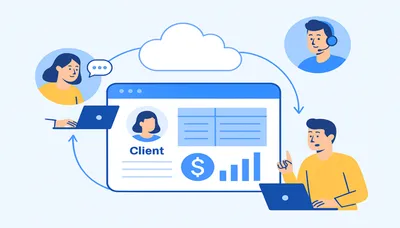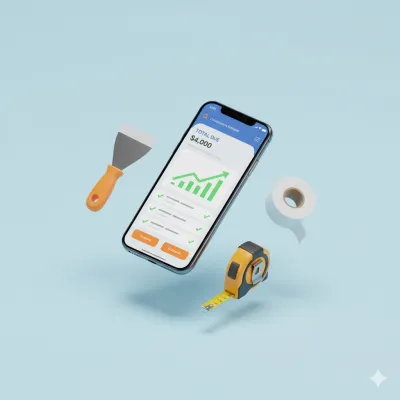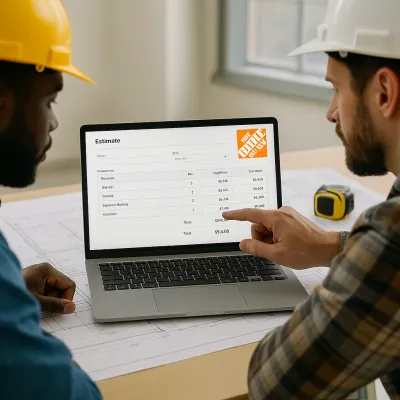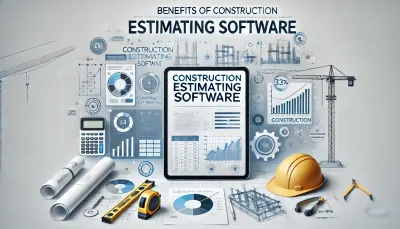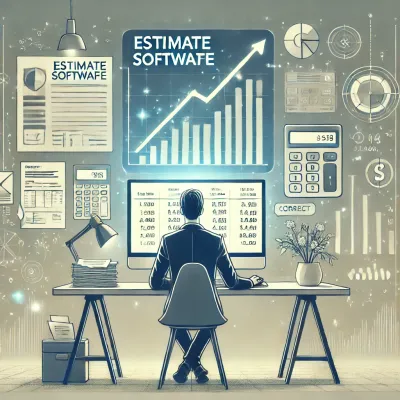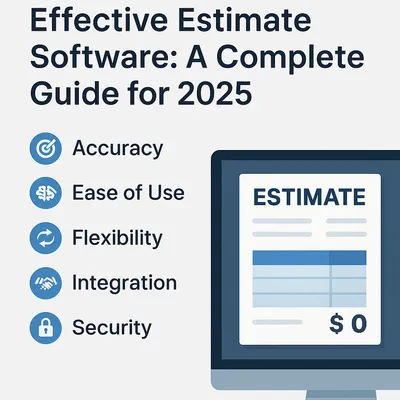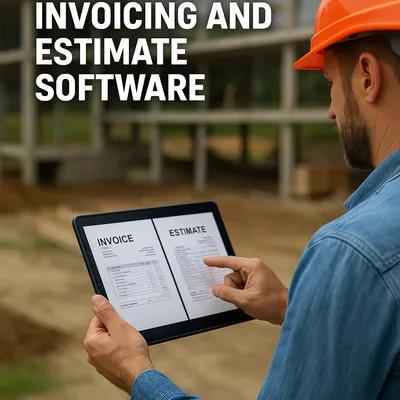Construction Estimating Software Guide 2025
Choose the best construction estimating software in 2025—boost accuracy, bid faster, and raise your profits with expert tips.
by
Gustavo Ferreyra • 6/14/2025
Construction Estimating Software Guide: What Top Contractors Won’t Tell You
Success or failure of today’s contractors depends heavily on construction estimating software. QuickBooks and TSheets research reveals a harsh reality - just two or three wrong estimates could put one in four firms out of business. This reality explains why choosing the right digital estimation tools matters so much in an industry where precision can make or break you.
Contractors need reliable solutions as construction spending hit $376.6 billion in 2022’s first quarter - a 12% jump from last year. The right contractor estimate software cuts takeoff time by 75% or more and boosts accuracy by a lot. The construction industry’s AI market shows promising growth too. Experts predict an expansion from $3.99 billion in 2024 to $11.85 billion by 2029, marking a clear transformation toward advanced estimation technology.
This piece gets into construction estimating software’s role in revolutionizing preconstruction work. You’ll learn which key features to think over when picking the best contractor software. We’ll review top estimation options for 2025 and uncover benefits that leading contractors rarely share openly. The insights here will guide your decision, whether you’re upgrading systems or starting fresh with digital estimating.
What is Construction Estimating Software?

Image Source: ConstructionPlacements
Digital technology has revolutionized the planning and execution of construction projects. Construction estimating software stands as the foundation of this change. These specialized digital tools help contractors predict costs during project planning.
Definition and purpose
Construction estimating software is a computer program that stores and processes construction cost data. These digital solutions have replaced traditional manual methods by automating complex calculations. Contractors can now create accurate budgets and secure more projects. The main purpose of estimating software is to determine the cost of a construction project by factoring in labor, materials, equipment, and overhead expenses.
Quality estimating software offers these key functions:
- Digital takeoffs – Measuring materials and labor needs directly from digital blueprints
- Cost databases – Accessing up-to-date pricing information
- Bid proposal generation – Creating detailed professional documents
- Cloud-based collaboration – Enabling team access from any location
Contractors can now convert client needs into line items, quantities, and total costs. The software eliminates formula errors and cell-reference errors that plagued spreadsheet-based estimating.
How it fits into the preconstruction process
Preconstruction marks the planning phase before physical work starts at the job site. Construction estimating software serves as the life-blood of this critical stage. The software provides reliable budgets, speeds up estimating, and reduces risks.
Estimators start by reviewing project plans and documentation to determine scope. Modern estimating solutions let teams see projects in 3D, which improves their understanding of design intent. The software then makes digital takeoffs faster by automating measurements and calculations.
Teams coordinate with clients to understand job requirements before calculating detailed costs. Cloud-based platforms allow live collaboration among team members whatever their location. This approach creates a standardized workflow where estimating, takeoff, and financial software blend naturally together.
Construction estimating software helps create a project roadmap. Teams can accurately predict costs, quantities, and labor hours before starting on-site work. This technology brings a standardized approach to estimating. Every project estimate now follows established rules and formats.
Why it matters for modern contractors
Today’s competitive construction world demands accurate cost estimation for survival. Poor estimates can derail projects before they begin. Companies must absorb additional costs when estimates miss items or calculations prove wrong. This directly impacts their profitability.
Construction estimating software solves several critical challenges:
Advanced algorithms and detailed, current data libraries dramatically improve accuracy. The software speeds up time-consuming processes that once took days or weeks to complete manually. Cloud-based platforms act as central hubs for all project information, which improves team collaboration.
The software exploits historical project data to make analytical decisions, reduce risks, and refine future estimates. Teams can spot cost trends and plan projects better through this analysis.
Construction estimating software has become vital for contractors in this technology-driven industry, and with good reason too. Companies that provide precise, reliable estimates quickly gain an edge over competitors using slower, less accurate methods.
Key Features to Look for in Estimating Software
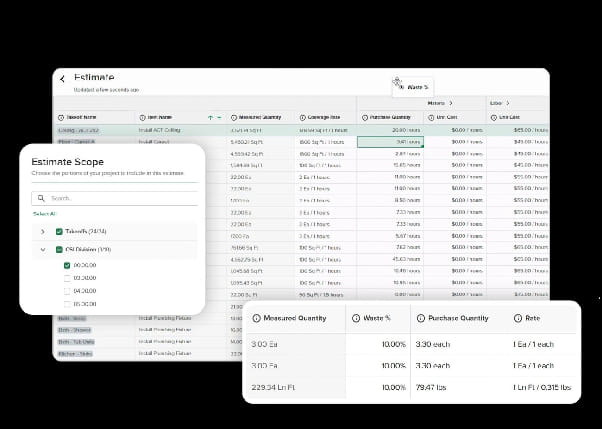
Image Source: STACK
Picking the right construction estimating software means taking a good look at features that match your business needs. Let’s get into what makes top solutions stand out from average ones with these six key capabilities.
Cloud-based access and mobility
Construction teams no longer stick to their office desks. Cloud-based estimating solutions let teams check project data anywhere using desktops, tablets, or smartphones. Your estimators can work quickly at job sites, client meetings, or away from the office.
Teams in the field can add data straight from construction sites. The offline mode lets work continue without internet. The data syncs automatically across devices once connected, which gives everyone a single source of truth. This smooth collaboration puts an end to chasing different spreadsheet versions through email.
2D and 3D takeoff capabilities
Advanced takeoff technology combines old and new methods. Good construction estimating software should offer both 2D and 3D takeoff tools in one package. Industry data shows contractors who use Building Information Modeling (BIM) can do takeoffs three to five times faster and cut their estimation time by half.
Using both 2D and 3D takeoffs helps catch everything and speeds up work by gathering data points in one tool. Estimators can pull quantities straight from models or drawings, which cuts down manual work and boosts accuracy.
Integration with accounting and project management tools
Good connections between estimating software and other business systems make work much easier. The best software connects smoothly with accounting systems like QuickBooks, Sage 300, and Vista. These links cut down on double data entry and help keep accounts accurate.
The top solutions also work well with project management tools like Primavera P6, Microsoft Project, and bidding software such as AASHTOWare and Bid Express. This network brings together finance, procurement, and project management teams with current project data.
Customizable templates and cost databases
Quality estimating software lets contractors create standard, reusable templates for different projects. These templates give you a head start on each new estimate. Most experienced users create 5-7 estimate templates each year based on similar project types.
Cost databases you can customize make work faster by keeping all pricing in one place. The best software gives you flexible database options. You can bring in data from old systems, use built-in databases, or tap into ready-made databases with local pricing. This approach helps keep estimates in line with market prices.
User-friendly interface and learning curve
An easy-to-use interface makes a big difference in how well teams adopt and use the software. The best platforms have clean designs with logical layouts that need minimal training. Look for software with familiar spreadsheet controls, quick inline editing, and views you can customize to show just what you need.
Simple interfaces help teams learn faster so they can focus on making accurate estimates instead of figuring out complex menus. This makes it possible for estimators at any skill level to create professional estimates.
Customer support and training resources
Great support services turn good software into something special. The best providers give you a dedicated project coordinator to handle setup from start to finish. This approach helps 95% of customers get up and running within 90 days.
After setup, ongoing help through live chat, email, phone support, and knowledge bases helps teams get the most from their software. Regular meetings with service teams keep implementations on track and make sure users keep getting value from their estimating solution.
Top Construction Estimating Software in 2025
The construction estimation market has several outstanding solutions that lead the industry in 2025. Here are eight top construction estimating software options that dominate the market today.
STACK
STACK provides powerful cloud-based takeoff and estimating capabilities with an easy-to-use interface that construction professionals love. The software’s collaborative features allow team members to work together on projects from anywhere. STACK’s professional proposal generation and detailed reporting capabilities have made users extremely satisfied.
ProEst
ProEst brings cost estimating, digital takeoffs, and bid day analysis together in one cloud-based solution. This complete platform helps companies boost their estimating productivity by 50% and bidding efficiency by 30%. The software’s built-in CRM capabilities help contractors maintain better client relationships, while pre-designed reporting templates ensure clear communication.
Clear Estimates
Clear Estimates caters to remodelers and smaller contractors with over 12,000 parts pre-loaded with material and labor costs specific to 400 regions across the US. The software offers more than 130 templates for common jobs like kitchens and bathrooms. Contractors can generate complete estimates within seconds.
Sage Estimating
Sage Estimating brings 30 years of market experience to deliver a complete end-to-end solution for the entire estimating workflow. The software cuts estimating time by up to 50% while maintaining nearly 100% accuracy. Users benefit from pre-populated cost databases, standardized templates, and BIM integration.
Buildxact
Buildxact meets the unique needs of residential builders and contractors. Users complete takeoffs up to 80% faster and quote projects 5x more quickly. The platform delivers a 16x return on investment in the first year. Builders earn 17% more revenue on whole-of-house builds compared to average builders.
PlanSwift
PlanSwift stands out as one of the fastest takeoff software options available. Users can measure, count, and calculate with point-and-click simplicity. The software adapts to various trades and blends naturally with Excel for additional analysis.
Estimator360
This construction management solution learns from previous projects to create better estimates. The digital takeoff tool makes bidding simple. Customizable assembly templates and dynamic estimating automatically update all required materials and labor when dimensions change.
CostX
CostX offers powerful 2D and 3D/BIM takeoff capabilities with live-linked workbooks that update immediately. The auto-revisioning feature spots and highlights changes between different drawing versions. This creates a complete audit trail that saves hours of manual work.
How to Choose the Best Estimating Software for Your Business
Finding the right construction estimating software goes beyond picking the most popular option. You need to match the right tool to your business needs.
Assessing your business size and project type
Your company’s size and project types affect your software needs by a lot. Small businesses and individual contractors get better results with user-friendly platforms like Clear Estimates and Buildxact that offer competitive pricing. Larger companies that manage complex projects need detailed solutions like Sage Estimating, STACK, or Procore with resilient features and integration capabilities.
Evaluating your current workflow and tools
Document your biggest estimating challenges before you select new software. You should analyze:
- Hours spent looking for information
- Common error locations
- Time lost switching between tools
Estimators spend more time gathering data than building estimates. Traditional methods like spreadsheets often cause problems, and note that 9 out of 10 spreadsheets have errors. Knowing these pain points helps you prioritize features that matter most to your team.
Budget considerations and ROI
ROI calculation for estimating software follows a simple formula: ROI = (Financial Gain - Cost of Investment) / (Cost of Investment). Think over the total ownership cost beyond the purchase price, such as:
Licensing fees, tech support, subscription services, installation costs, and training. Quality estimating software saves about 50% of time usually spent on estimates. An estimator with a $90,000 yearly salary could save $540 per bid.
Importance of free trials and demos
Free trials and demos are a great way to get experience before you commit. You can test the user interface and see if the software matches your workflow. Your trial periods work best when you:
Pick 1-3 potential solutions, ask for demos before trials, get your team involved, and test with actual project data instead of sample information. This hands-on approach shows whether the software tackles your specific challenges effectively.
Benefits of Using Estimating Software
Data shows that quality estimating software delivers measurable returns for contractors of all sizes. Let’s get into the key advantages that make companies adopt this technology.
Improved accuracy and reduced errors
Manual estimating processes naturally lead to errors. In fact, 48% of construction professionals purchased new estimating software in the last year to improve cost estimation accuracy. This investment pays off—companies using digital estimation tools report 15-20% increases in profitability across most projects. Some jobs even see profit increases up to 50%.
Estimation software eliminates common calculation errors through built-in formulas and automated extensions. The technology spots potential cost issues during the estimating stage, especially when you have Building Information Modeling (BIM) software that detects component clashes before construction begins. Advanced error-detection features like “Check Bid” tools catch missing line items and discrepancies that protect bids from getting pricey mistakes.
Faster bid preparation
Time savings make construction estimating software even more valuable. Tasks that once took hours in spreadsheets now take minutes. One contractor finishes daily paperwork by 3:45 PM instead of working late hours. Another contractor reported that two-hour Excel tasks now take less than 30 minutes.
Some contractors have tripled their bid volume—from handling five bids at once to 15—without sacrificing accuracy or detail. Create and send a simple invoice to your customers fast and easy with QUICKADMIN, similar to how modern estimation tools streamline complex calculations to optimize efficiency.
Better collaboration and communication
Construction estimating software encourages teamwork through centralized platforms where multiple users can access and edit estimates at the same time. This feature significantly reduces miscommunications throughout the estimating process. Precise details and data remain available to all team members.
Many solutions include audit trails that track changes and updates within project estimates to help pinpoint the source of discrepancies. Without doubt, this transparency creates accountability and cohesive teamwork.
Enhanced client trust and professionalism
Detailed line item breakdowns provide transparency to clients that reduces resistance to change orders. Professional, consistent proposals help contractors stand out from competitors who still use outdated methods.
Clients receive complete estimates that demonstrate value beyond price quotes. This transparency builds credibility by showing clients their exact investment, which sets realistic expectations and prevents disputes.
Conclusion
The Bottom Line: Making Your Estimating Software Investment Count
Construction estimating software marks a major change from old methods to evidence-based precision. This guide shows how digital tools revolutionize the preconstruction process through automation, collaboration, and accuracy. Your business profits directly when the right software cuts errors and speeds up bid preparation.
Picking the best estimating software needs a good look at your business size, project types, and current workflows. Smart companies review their options based on specific needs instead of picking the fanciest platform. You can best judge if a solution fits your team’s needs by trying free trials and demos.
The construction world changes faster every day as AI and cloud technologies reshape how we estimate. Contractors who welcome these advances set themselves up to win in a tough market. Those stuck with old methods risk falling behind while their rivals use technology to create faster, more accurate bids.
Numbers tell the real story - contractors who use quality estimating software see 15-20% more profit across most projects. This return makes the original cost and learning curve worth it. These tools also help build better client relationships through professional work and clear communication.
Your choice to invest in construction estimating software comes down to protecting your business’s future. Companies that use digital tools to standardize their estimates build a foundation for steady growth and reliable project delivery. Contractors now need to focus on finding the right solution that matches their goals and helps them succeed in 2025 and beyond.
FAQs
Q1. What are the key benefits of using construction estimating software? Construction estimating software improves accuracy, reduces errors, speeds up bid preparation, enhances collaboration, and increases profitability. Companies using digital estimation tools report 15-20% increases in profitability across most projects.
Q2. How does cloud-based estimating software improve workflow? Cloud-based estimating solutions enable teams to access project data from any location using various devices. This flexibility allows for real-time collaboration, data syncing across devices, and the ability to work efficiently whether on job sites, in client meetings, or from remote locations.
Q3. What features should I look for in construction estimating software? Key features to consider include cloud-based access, 2D and 3D takeoff capabilities, integration with accounting and project management tools, customizable templates and cost databases, a user-friendly interface, and comprehensive customer support and training resources.
Q4. How do I choose the best estimating software for my construction business? To choose the best software, assess your business size and project types, evaluate your current workflow and tools, consider your budget and potential ROI, and take advantage of free trials and demos. It’s important to match the software capabilities with your specific business needs.
Q5. Can estimating software help with client communication and trust? Yes, estimating software enhances client trust and professionalism by providing detailed line item breakdowns, which offer transparency and reduce resistance to change orders. Presenting comprehensive estimates demonstrates value beyond just price quotes and helps set realistic expectations, avoiding disputes.

